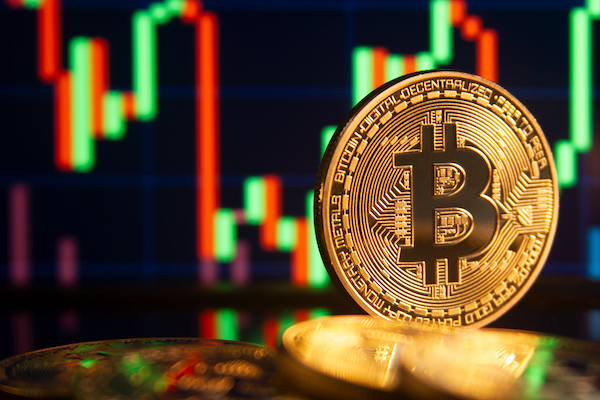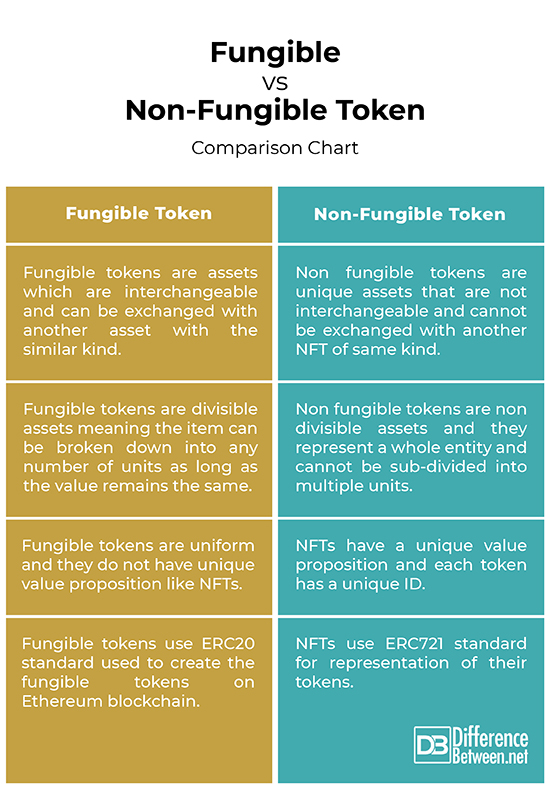Difference Between Fungible and Non Fungible Tokens
Tokens, also referred to as crypto tokens, are a type of cryptocurrency that represents an asset and can be anything of value. Whether you believe it or not, the technology of blockchain is here to stay, and so is Ethereum. With cryptocurrencies making a case for their real world value and legitimacy, NFTs are the next big evolution in this ever-changing digital world. The pandemic accelerated digital technological changes overnight and NFTs became a legitimate business.

What is Fungible Token?
Bitcoin and other cryptocurrencies are examples of fungible tokens. Dollars, stocks or bars of gold are fungible assets. Fungible tokens are divisible assets which are not unique and can be readily exchanged for another asset of like kind. Such tokens are made in a way that each fraction of a token is equivalent to the next. Bitcoin is the most used cryptocurrency and is fungible. Fungibility, in general, is the property of a commodity whose individual units are essentially interchangeable. It’s the capability of an asset to be interchangeable with another asset for same value.

What is Non-Fungible Token?
Non-fungible tokens (NFTs) are a new innovation in the blockchain/cryptocurrency space that enables you to track who owns a particular asset. Non fungible simply means something which is unique and cannot be exchanged for another item. NFTs are like real world items of some value. They are kind of digital assets that can be bought and sold online, frequently with cryptocurrency. NFTs represent a whole entity and cannot be sub-divided into multiple pieces. The concept of NFT is based on blockchain technology, particularly Ethereum blockchain. NFTs are basically units of data stored on blockchain that certify digital asset to be unique. And they can be used for a wide range of digital commodities such as photos, audio, video, and other digital files.
Difference between Fungible and Non Fungible Tokens
Terminology
– Fungibility is the property of a commodity whose individual units are essentially interchangeable. It’s the capability of an asset to be interchangeable with another asset for same value. For example, if you borrow a $100 note from your friend, you need to pay him back with the exact same value, but not necessarily the exact same note. You can pay him two $50 notes or ten $10 notes. But, if you borrow your friend’s car, you cannot return him some other car. So, a car counts as a collectible and it’s unique, which is why it is non-fungible. Non-fungibility is the property of uniqueness of an asset.
Property
– Non-fungible tokens (NFTs) are basically units of data stored on blockchain that certify digital asset to be unique. The concept of NFT is based on blockchain technology, particularly Ethereum blockchain. Fungible tokens, on the other hand, are non divisible assets which are not unique and can be readily exchanged for another asset of like kind. NFTs are non divisible whereas fungible tokens are divisible.
Standard
– Fungible tokens use ERC20 standard which is one of the most significant Ethereum tokens based on blockchain technology, similar to ether, Bitcoin, and Bitcoin cash. It is one of the best blockchain protocols. Non fungible tokens, on the other hand, use ERC721 standard on Ethereum, allowing developers to tokenize ownership of any arbitrary data. This standard is used in many cases were you want to transfer a whole asset that cannot be broken down into multiple points.
Fungible vs. Non-Fungible Token: Comparison Chart

Summary
As we are going digital day by day, NFTs present a practical solution for ownership of tokens, which allow digitization of real world assets. Hence, NFTs are proved to be more useful, considering they have a unique value proposition and they are non divisible. NFTs represent a whole entity and they cannot be sub-divided into multiple units. Fungible tokens, on the other hand, are easily divisible and the items can be divided into any number of units as long as their value remains the same and each token can be exchanged with another token with similar type and of the same value. NFTs are unique and non-interchangeable, and they cannot be exchanged with another non fungible token of similar kind.
What is the difference between ERC20 and ERC721?
ERC20 is a fungible token standard that’s used to create the fungible tokens on Ethereum blockchain, whereas ERC721 is a non-fungible token (NFT) standard in which an NFT is non-divisible and non-fungible.
What are non fungible tokens medium?
They are a type of cryptographic token on a blockchain that represents a single asset and they are bought and sold online.
Do non-fungible tokens have value?
They can be used to represent ownership of unique items. Each NFT represent a different underlying asset and so, they have a different value.
How do you get non-fungible tokens?
NFTs are digital investments that are joined and distinctive, and they can be employed to depict both substantial and immaterial elements. NFTs can be bought using various currencies; in fact, there are several marketplaces to buy and sell NFTs.
- Difference Between Caucus and Primary - June 18, 2024
- Difference Between PPO and POS - May 30, 2024
- Difference Between RFID and NFC - May 28, 2024
Search DifferenceBetween.net :
Leave a Response
References :
[0]Hines, Baxter. Digital Finance: Security Tokens and Unlocking the Real Potential of Blockchain. New Jersey, United States: John Wiley & Sons, 2020. Print
[1]Chittoda, Jitendra. Mastering Blockchain Programming with Solidity: Write Production-ready Smart Contracts for Ethereum Blockchain with Solidity. Birmingham, United Kingdom: Packt Publishing, 2019. Print
[2]Lee, David. Handbook of Digital Currency: Bitcoin, Innovation, Financial Instruments, and Big Data. Massachusetts, United States: Academic Press, 2015. Print
[3]Image credit: https://www.quoteinspector.com/media/bitcoin/bitcoin-trading-volatility.jpg
[4]Image credit: https://commons.wikimedia.org/wiki/File:NFT_Non_Fungible_Token_-_Explained.jpg
